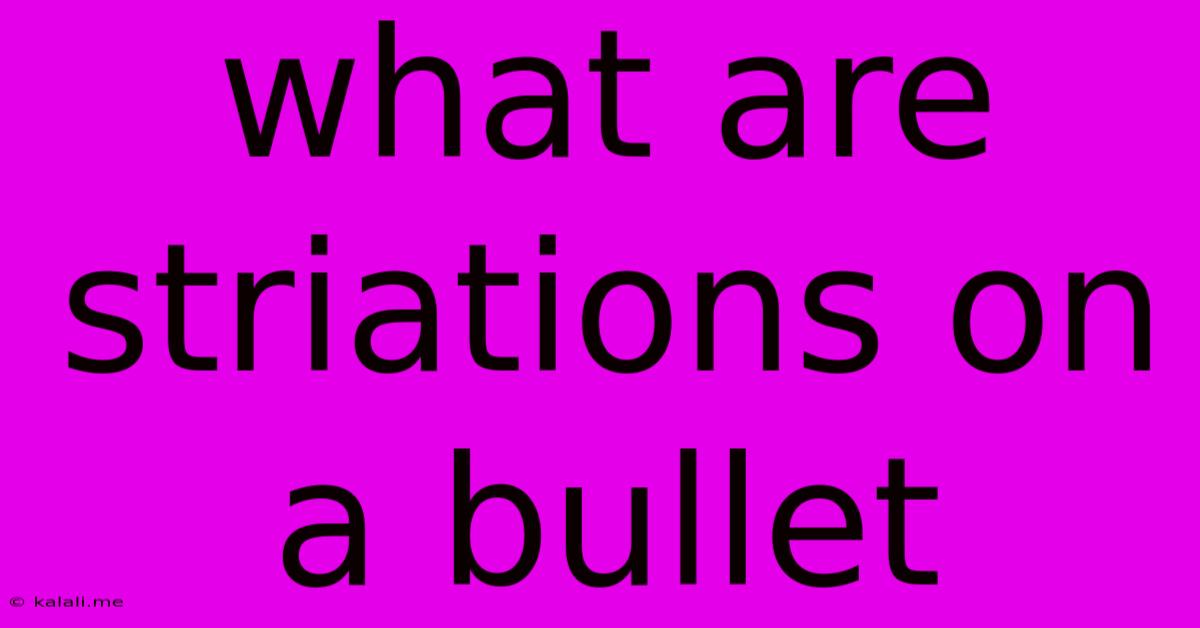What Are Striations On A Bullet
Kalali
May 10, 2025 · 3 min read

Table of Contents
What are Striations on a Bullet? Understanding Bullet Markings for Forensic Analysis
Bullet striations are microscopic markings etched onto a bullet as it travels down the barrel of a firearm. These unique imperfections are crucial in forensic ballistics, allowing investigators to link a bullet found at a crime scene to a specific weapon. Understanding these striations is key to solving crimes and ensuring accurate forensic analysis. This article delves into the nature of bullet striations, their formation, and their significance in criminal investigations.
What Causes Bullet Striations?
As a bullet is fired, it's forced through the rifled barrel of a gun. The rifling, a series of helical grooves cut into the barrel's interior, imparts spin to the bullet, increasing its accuracy and stability in flight. The interaction between the bullet's surface and the rifling's lands (the raised portions between the grooves) and grooves creates friction. This friction causes microscopic imperfections – the striations – to be impressed onto the bullet's surface. These are not uniform; they are unique to each individual firearm due to manufacturing imperfections and wear and tear on the barrel.
The Uniqueness of Striation Marks:
The key aspect of bullet striations lies in their individuality. No two barrels are exactly alike. Even guns of the same make and model will possess subtly different rifling patterns, resulting in unique striation markings on the bullets they fire. These minute differences are magnified through microscopic examination, creating a distinctive fingerprint for each firearm. This principle forms the foundation of forensic ballistics and its use in linking bullets to weapons.
How Forensic Scientists Analyze Bullet Striations:
Forensic scientists use comparison microscopes to analyze bullet striations. These specialized microscopes allow for side-by-side comparison of a test bullet fired from a suspected weapon and a bullet recovered from a crime scene. By carefully aligning and comparing the striation patterns, experts can determine whether or not the bullets share a common origin. The process involves:
- Microscopic Examination: Highly detailed images of the bullet striations are captured using specialized microscopes.
- Pattern Comparison: The striation patterns of the test and recovered bullets are compared, looking for similarities in their overall pattern and individual markings.
- Matching Criteria: Experts establish specific criteria to determine a match, considering the number and nature of matching striations. A perfect match is not always required; statistical analysis plays a significant role in the interpretation of the comparison.
Beyond the Basics: Factors Affecting Striation Formation:
Several factors influence the formation of bullet striations, adding complexity to the analysis:
- Barrel Wear: As a firearm is used, the barrel experiences wear and tear, subtly altering the rifling and impacting striation patterns over time.
- Bullet Material and Composition: The type of bullet material (e.g., lead, jacketed) can affect how striations are formed and their clarity.
- Ammunition Variations: Differences in ammunition can also lead to minor variations in striation patterns.
- Cleaning and Maintenance: Cleaning the firearm can affect the striations, although generally less impactful than wear and tear from repeated use.
The Importance of Bullet Striation Analysis in Criminal Investigations:
The analysis of bullet striations is a powerful tool in criminal investigations. It can provide crucial evidence linking a firearm to a crime scene, helping to:
- Identify the weapon used: Connecting a recovered bullet to a specific firearm is vital for establishing the chain of events in a crime.
- Exclude suspects: If the striations on a bullet don't match those from a suspect's weapon, it can exonerate that individual.
- Build stronger cases: Providing a definitive link between a weapon and the crime strengthens the prosecution's case and enhances the likelihood of a conviction.
In conclusion, bullet striations are unique microscopic markings that provide crucial forensic evidence. Their formation, analysis, and significance in criminal investigations underscore the importance of this technique in modern forensic science. The detailed examination of these seemingly insignificant marks helps solve crimes and brings justice to victims.
Latest Posts
Latest Posts
-
Words That Start With Y In Science
Jul 12, 2025
-
Prevent An Expressway Emergency By Merging Without
Jul 12, 2025
-
How Many Grams Of Sugar In A Pound
Jul 12, 2025
-
7am To 11am Is How Many Hours
Jul 12, 2025
-
If Your 35 What Year Was You Born
Jul 12, 2025
Related Post
Thank you for visiting our website which covers about What Are Striations On A Bullet . We hope the information provided has been useful to you. Feel free to contact us if you have any questions or need further assistance. See you next time and don't miss to bookmark.